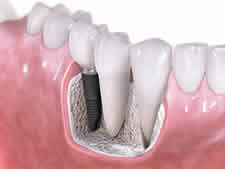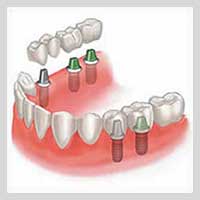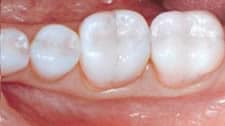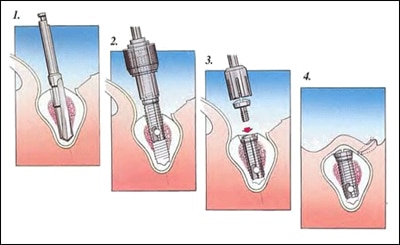Dental Implants

The biocompatible titanium implants are safe and durable. Over the past 30 years, thousands of implants remain sound and function like natural teeth. Implants require the same diligence in homecare and professional maintenance as all teeth. This means they can easily last a lifetime without complications.
Age is not factor in implant candidacy. Most people in good overall health can opt to have an implant placed with little risk of failure. To have an implant placed you should have healthy teeth and gums and adequate bone to support the implant. If you are ready to replace one or more missing teeth, let’s set up a consultation to talk about it.
Full Mouth Restoration

There have been many wonderful advances in restorative dentistry in the past several years, and today there is truly no good reason for you to feel uncomfortable.
Most of us require some type of dental restorative work, such as fillings, crowns or bridges, during our lifetimes. Due to our extensive experience and commitment to continuing education, Dentistry on the Hill offers patients the latest technology, materials and procedures.
Same-Day Dental Implants / Immediate Load Dental Implants

At Ufberg Dental, utilizing immediate load implants the tooth restoration (temporary or permanent), can be attached (loaded) on the implant in the same day immediately after the implant is placed in the jawbone.
Traditional implant procedures require a two-stage process. The implant is placed during the first surgical procedure followed by several months of healing period, waiting for the implant to integrate with the jawbone. Then the implant is uncovered during a second surgical procedure, the abutment is placed on the implant and finally the restoration is cemented on the abutment.
With immediate load implants, a single-stage process now eliminates the waiting time for healing and need for a secondary surgery. Dr. Ufberg is proud to offer this far less invasive and patient-freindly treatment at Ufberg Dental.
To find out if you’re a candidate for Same-Day/Immediate Load Dental Implants, schedule your consultation with Aaron Ufberg, DMD today at 610-251-2227.
Multiple Teeth Implant Bridge

Mini dental implants are still made from the same high quality implant material but their smaller size increases the versatility of treatment. You may also hear these dental implants referred to as small diameter implants or narrow body implants.
Takes Several Months to Heal
With this option the implants need to be left to heal and integrate with the jawbone so the entire process can take several months to complete. During this time you will be provided with a temporary prosthesis, for example a removable partial denture to ensure you can eat and speak properly.
Root Canal Therapy

All teeth have between one and four root canals.
Many tooth problems involve infections that spread to the pulp, which is the inner chamber of the tooth containing blood vessels, nerves and other tissues. When the infection becomes worse, it can begin affecting the roots. A traumatic injury to a tooth can also compromise the pulp, leading to similar problems.
A diseased inner tooth brings a host of problems including pain and sensitivity as the first indications of a problem. However, inside a spreading infection can cause small pockets of pus to develop, which can lead to an abscess.
Root canal therapy is a remarkable treatment with a very high rate of success, and involves removing the diseased tissue, halting the spread of infection and restoring the healthy portion of the tooth. In fact, root canal therapy is designed to save a problem tooth; before the procedure was developed and gained acceptance, the only alternative for treating a diseased tooth was extraction.
Procedure
Root canal therapy usually entails one to three visits. During the first visit, a small hole is drilled through the top of the tooth and into the inner chamber. Diseased tissue is removed, the inner chamber cleansed and disinfected, and the tiny canals reshaped. The cleansed chamber and canals are filled with an elastic material and medication designed to prevent infection. If necessary, the drilled hole is temporarily filled until a permanent seal is made with a crown.
Most patients who have root canal experience little or no discomfort or pain, and enjoy a restored tooth that can last almost as long as its healthy original.
Porcelain Dental Veneers
Interested in improving your smile? Take a look at your front teeth. Are they chipped, discolored, or slightly crooked? Do any teeth tarnish an otherwise fantastic smile? You may be a perfect candidate for porcelain veneers.
Porcelain veneers are thin shells that are bonded to the front of one or more teeth to mask flaws and imperfections. They are stronger and longer lasting than fillings, and like crowns, veneers provide strength to the teeth. Unlike crowns, only a small portion of tooth surface is removed. More of your healthy tooth structure can be preserved. Veneers are translucent, allowing light to pass through them, making them look like your natural teeth and this means people notice you, not your veneers. What is most exciting is that veneers can close gaps, correct chips, and adjust the look of crowded teeth making them look straighter and more beautiful, many times in only 2 visits. When you are interested in making changes to your smile in the most natural way, veneers are the obvious choice.
Porcelain Crowns

Although there are several types of crowns, porcelain (tooth colored crown) are the most popular, because they resemble your natural teeth. They are highly durable and will last many years, but like most dental restorations, they may eventually need to be replaced. Porcelain crowns are made to match the shape, size, and color or your teeth giving you a natural, long-lasting beautiful smile.
White Tooth-Colored Fillings

Because composite fillings are tooth colored, they can be closely matched to the color of existing teeth, and are more aesthetically suited for use in front teeth or the more visible areas of the teeth.






